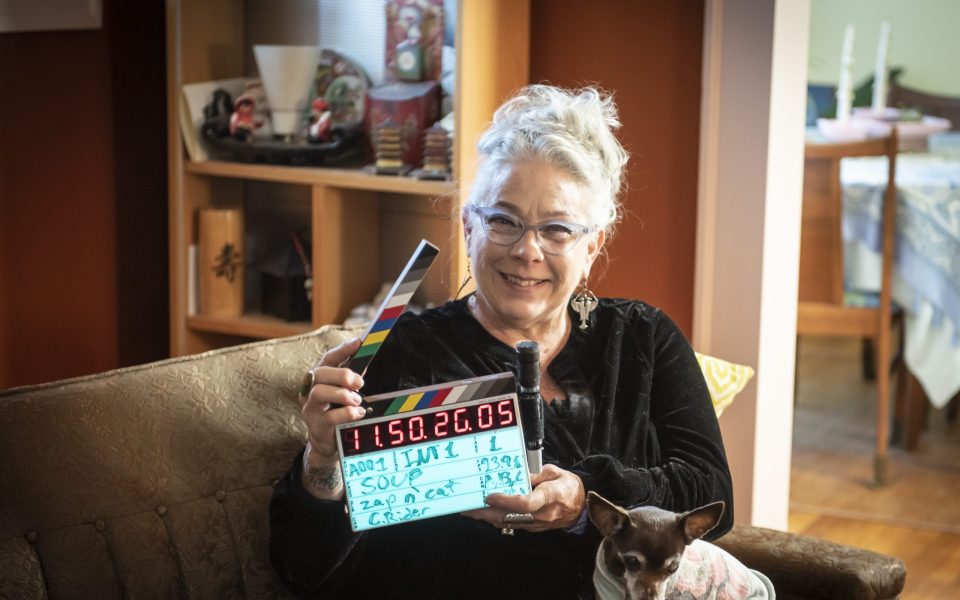Featured photo: Mary Haglund poses in the ‘How to Feed an Artist’ documentary (photo by Christine Rucker)
Cynthia J. Giles sold her restaurant to Mary Haglund under two conditions: 1. The Art-o-mat, a vintage cigarette vending machine repurposed to dispense cigarette pack-sized art, stays in the building and 2. Haglund must continue Giles’ tradition of hosting monthly art shows. Haglund agreed and set up shop in the space on Brookstown Avenue in Winston-Salem in 2000, renaming it Mary’s Of Course.
The restaurant became a creative’s sanctuary almost immediately, featuring drag brunches, fashion shows and other events being hosted there, too.
How to Feed an Artist, a feature-length documentary by filmmakers Zap McConnell and Cat Rider, explores Haglund’s journey and takes an in-depth look at the relationships between the restaurateur and the surrounding community of artists and service-industry workers. The idea of combining art and food makes sense because according to McConnell, artists tend to have firsthand experience with food service.
“If you are in film or dance or you’re a visual artist or musician,” she explains, “you’ve more than likely have had to supplement your income working in a restaurant.”

Mary’s Of Course was no exception; Haglund would hire local artists to work there, including McConnell.
The documentary came to life during a conversation that Haglund and McConnell were having on mutual friend Liz Simmons’ porch. Simmons, a local artist who has worked as a server, will appear in the film.
In 2010, the restaurant relocated to Trade Street under a new name, Mary’s Gourmet Diner. But the plastered walls made it impossible to continue the tradition of monthly, interchangeable art shows, so Haglund sought a lasting solution.
“She went out and got five of her favorite artists and commissioned us to make permanent art pieces in that restaurant,” McConnell recalls.
Haglund insisted that the artists creating the pieces, as well as the process of moving to a larger eatery, be filmed for a documentary she wanted to create one day. This footage, in addition to interviews with Haglund, former employees and community artists make up How to Feed an Artist.

The documentary is being created in partnership with Storyocity, a video production company, and is currently in the pre-production phase. The co-directors have been busy with crowdfunding efforts, aiming to raise $50,000 for creative development and production of the film. They also needed footage when applying for grants, so they recorded events Haglund hosted, like a one-day Mary’s Gourmet Diner pop-up held this past April at Mojito Latin Soul Food in Winston-Salem, the diner’s former location.
“She never got to have closure during the pandemic; We scrambled to get our equipment and interview customers and film that whole experience,” McConnell says.
In 2020, the temporary-turned-permanent closing of Mary’s was met with disappointment and sadness from the community. In a video posted to Facebook in May of that year, Haglund further explained the closure, citing an unwillingness to be a takeout restaurant, safety concerns for employees and customers and the inability to maintain her close-knit vision of the restaurant.
“My whole concept has always been one of hospitality,” Haglund says. “You come to Mary’s and get a hug and a kiss. Everything is just very close.”
The film is planned for a release in September 2026.
McConnell first began filmmaking a decade ago, when she was introduced to and instantly fell in love with the fluidity and grace of dance on film. When Haglund remembered this, she asked her friend for help.
“Mary reached over and grabbed my arm with little teardrops in her eyes, and she gave me that puppydog look and sincerely asked me if I would help her with the film,” McConnell says.
How to Feed an Artist is McConnell and Rider’s third project together, the first two being short dance films. McConnell chose Rider to co-direct as she also has a personal tie to restaurant work.
“She also paves her way in life in between all her gigs in the film industry by working at a bakery,” she says.

McConnell’s relationship with the film is especially intimate since she’s been friends with Haglund for more than 30 years. The two first met while working at the now-closed Rainbow News & Café in Winston-Salem where Haglund was the head cook and McConnell waitressed while attending UNC School of the Arts.
“Throughout the years, she always wanted to open her own restaurant, and I made a pact with her that I would help her do that if she was ever able to,” McConnell explains.
Through the film, the directors highlight Haglund’s position as a staple in the art community and the lifelong relationships she’s built by serving a menu of fresh food from local ingredients, eclectic artistry and lots of love.
To McConnell, the film is her own token of appreciation to the restaurants and community artists that have supported her, and she wants viewers to acknowledge the large impact small businesses can make.
“For me it’s a love letter that says ‘Look at these family-owned restaurants and how much they can do in your community,’” she says.
Support How to Feed an Artist at gofund.me/19d4b041. Find more information about the film and see archived images from the restaurants at howtofeedanartist.org. Learn more about Zap McConnell at zapmcconnell.com.
Join the First Amendment Society, a membership that goes directly to funding TCB‘s newsroom.
We believe that reporting can save the world.
The TCB First Amendment Society recognizes the vital role of a free, unfettered press with a bundling of local experiences designed to build community, and unique engagements with our newsroom that will help you understand, and shape, local journalism’s critical role in uplifting the people in our cities.
All revenue goes directly into the newsroom as reporters’ salaries and freelance commissions.


Leave a Reply